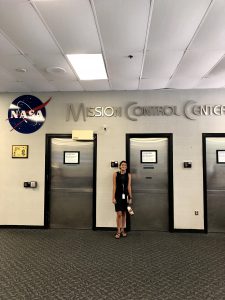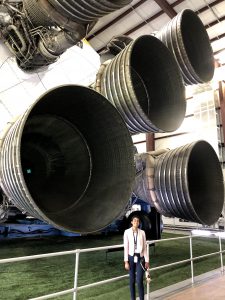Excuse the bad pun. But when you’re lucky enough to work for NASA for a while, sometimes you just can’t help it.
While I haven’t worked in many office buildings, I think the day-to-day at NASA Headquarters is much the same as any other office, albeit with a few more space-themed posters and wall hangings around. I came in each day, logged in, and spent the day googling acronyms, reading documents, and writing conclusions, with a lunch break spent with other interns listening to speakers from around the building (once, an astronaut!). Because I was in Washington, I also got to attend various Congressional hearings, and even met Dr. Christine Darden, who was one of the researchers featured in Hidden Figures (the book).

But, of course, the content of those documents and conclusions is what’s exciting.
I interned in the Office of the Chief Health and Medical Officer, which boils down to about fifteen people handling all of NASA’s health policies, both for astronauts and employees in terms of occupational medicine. Needless to say, they are all quite busy. But each one of them managed to find a few hours to spend with a young intern looking to enter their field, aerospace medicine, and from them I learned just how much NASA serves the public on the health side of their operations. Research is being conducted on the International Space Station (ISS) that benefits efforts to combat forgotten diseases in the developing world, and rocket parts make up a key component of every pacemaker, to name a few. As we journey further into outer space, we’ll learn more about the effects of microgravity on the human body, which will benefit aging, stress, and bone research back on Earth. At the end of the summer, the office sent me to Johnson Space Center in Houston to see how everything medical that NASA does is actually carried out. Between touring famed locations, like Mission Control and the Neutral Buoyancy Laboratory, and meeting young flight surgeons who care for the astronauts aboard the ISS, it made me off-the-charts excited to go down this career path myself.


It’s not just the tangible benefits, however, that made my work exciting. During my senior year of high school, I wrote and presented an original research paper on how missions to Mars can unite humans as a species. I wish I could go back in time and reference what I saw this summer, specifically on July 20, 2019: the fiftieth anniversary of the Apollo 11 Moon landing and the first time we set foot on another world. There were celebrations all over DC, and the office was buzzing with excitement the entire week. My boss, possibly the busiest and most dedicated person I’ve ever met, even took an afternoon off to visit the National Air & Space Museum with me and tell me about the medical side of each artifact in it.
The thing about that weekend that will always be cemented in my brain, though, was at 11:30 pm on the anniversary itself, which ended up being a sweltering, muggy, generally-miserable-to-be-outside day. My friend and I rushed to catch the projection on Washington Monument, hoping some of the crowds would have cleared out by that time of night. We were dead wrong. The National Mall was so packed around the screens that it was impossible to walk through the middle of it. At first I was a little frustrated, but as the Saturn V rose on the Monument and JFK’s famous speech filled the air, I found myself marveling that all of these people hailing from all over the globe– very few of whom were even alive when the Moon landing occurred– had come together to watch. It was the perfect vindication of all the work I’d done the previous year, and it gives me a great amount of hope for the future of humanity. It is truly incredible what we can accomplish together.

My project was to review the medical debriefs from the Apollo missions and compare them to NASA’s current human spaceflight requirements, which are centered around the ISS. Now that we’re aiming to return to the Moon with the Artemis missions, those requirements will need to be updated to incorporate a longer journey as well as landings in gravity. While the physicians will provide the technological expertise in how the requirements will actually be updated, my recommendations give them guidelines as to where to look.
This summer, I’ve learned that any human spaceflight truly does take a village. It has been such a privilege to be a small part of our next giant leap.

